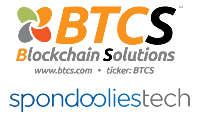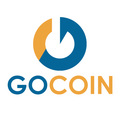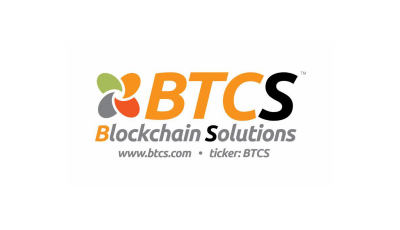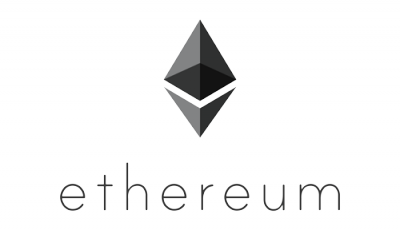A Conversation with Charles Allen, CEO of BTCS [Audio + Transcription]
Last week, I had the pleasure to speak with Charles Allen, CEO of BTCS. The company announced in late February the clearing of a major hurdle with the Israeli Office of Chief Scientist (OCS) regarding their merger with server manufacturer Spondoolies-Tech.
BTCS is the first United States public company to deal within the digital currency and blockchain space. In the media clip below, you can hear our discussion about Charles’ careers, the merger with Spondoolies and what it’s like being the first company within the industry to work with government regulators including the SEC.
Below you can read the full transcription of our interview.
Carlo: Can you tell us about your background as an engineer and then how you got involved with finance and eventually into blockchain technology?
Charles: I was a mechanical engineer… at Lehigh. Basically in 1999, I graduated and I worked for a compound semiconductor company called EMCORE, and then went onto a startup in California called Agility Communications making lasers for the fiber optic industry. I lived through the internet bubble bursting at a startup.After that I went back and got my MBA. I decided I wanted to move to the finance side, got my MBA at William & Mary and worked at a couple boutique investment banks in New York City helping smaller and mid-cap companies raise capital, do IPOs as well as mergers and acquisitions. I worked on the Jamba Juice deal – [on] the back end of that – American Apparel and a few others, a lot of smaller ones as well.
In 2013, I had the Bitcoin Shop come across my desk and it was just kind of the perfect timing if you think about a “needle in a haystack.” I was looking to move back into technology and away from the investment banking side. I was looking for something that incorporated a public company and that had to do with finance… and something in Washington, DC. If you take all of those things and put them together, it’s an impossible ask. Basically, the two founders of the company Bitcoin Shop had created an eCommerce website that connected to Amazon and used BitPay as a payment processor [which] had been approached by an investor group to go public via reverse merger with a $2 million financing. So that’s how I got involved in the company. It hit my desk, I got involved, I renegotiated the deal, increased the valuation by about 30%… we closed the transaction in about 3 weeks.
As part of going though that process I took over as CEO. I knew what bitcoin was, I knew what blockchain was, but I was very new to the space. The opportunity I saw was not so much on the eCommerce side but [that] having the first public company in the bitcoin and blockchain ecosystem was very valuable. Think of it as if you have the first pubic company at the beginning of the internet. It’s a very unique value proposition. A lot of people say “why didn’t you focus on eCommerce more?” and the reality is do what you know best. I mean … I understand that side but also being a former investment banker, with 10 years having done that recently, searching the public market, I viewed it as an opportunity to do a rollup strategy and make strategic investments.
We still have our eCommerce side but it’s hard to get people to send their bitcoins when [their price is] down, you know. Competing with Overstock and Tigerdirect and all these other companies which are also struggling on the eCommerce side isn’t really practical, especially given the hoarding nature of a lot of… people that hold bitcoin. We’ve been kind of hoarding our bitcoin, too, so I can’t blame customers to act the same way I would.
So that’s kind of how we got started. We made four strategic investments. We’re the only strategic investor in Gem. They just completed a $7 million round. We’re the lead investor in GoCoin. It’s really a unique opportunity to provide the public market with access to some of these other companies that they otherwise would not [have access to].
Really one of the things I looked at was where’s the cash cow in this industry? How do you make money? [With] public companies you don’t really have the luxury of building beyond the horizon, building solutions that’ll be used in two to five years. I’m judged on a quarterly basis. I’m judged, unfortunately, based on net income which has got a lot of non-cash charges but [that] is a whole different bag of worms.
Again in 2014 we looked at mining – we stayed away from the space for a while because it was an arms race we didn’t think we could win – but [this time] to vertically integrate. We thought the timing was kind of perfect to take a contrarian view. That’s when we were customers of Spondoolies and that’s kind of when the process with Spondoolies started. Now we’re the third largest investor in the company. We’ve invested $2.25 million. We own 9.6% of the company. We’re slowly chipping away at some of these closing requirements for our merger, with the goal of vertically integrating. In my mind, I think mining is kind of the cash cow in the industry. It’s where you can make money today and it’s a great foundation to build on top of other blockchain technology solutions, whether that’s through organic growth or through acquisitions.
Carlo: I know the approval from the OCS was the first of two big hurdles in order to move along with the merger. How does it feel to clear that first hurdle? Was it something you were expecting or was it something that you guys were still unsure of until now?
Charles: The hurdles with the merger aren’t the things that keep me up at night and I’ll tell you what keeps me up at night, which is a hurdle we just cleared that most people in both the bitcoin and blockchain spaces don’t even realize we cleared…
Mergers take time… you signed an LOI…last year and it seems like forever ago. It was a nonbinding LOI and… we needed to close a round to really move this forward. It took us three and a half weeks to raise $2.3 million. We closed that and I wanted a break fee. I wasn’t going to invest in a company that I was gonna merge with without protecting my shareholder base. It took us another month to negotiate the break fee and some of the other conditions. After that we started negotiating the definitive [contract] and that took another three months, which is not an unreasonable amount of time for international merges – a lot of tax considerations and other considerations. I think it was September 21st or 20th, around there, when we actually signed the merger docs, which after signing those docs [was] when we could start going after these approvals.
When you look at the timing – I know a lot of my investor base, a lot of people in the community, it looks like forever, but for the type of deal we’re going [after], it’s not an unreasonable timeframe. You’re asking for government approval and the government does not move at the same pace. The Israeli government and US government do not move at the same pace that private industry does.
Carlo: Do you know when you’re going to hear from the Israeli Tax Authority about what they need to approve regarding the tax referrals?
Charles: I think we’re getting very close. One of the things were actually looking to do – and this is kind of, you know when I said the things that keep me up at night – is clearing the SEC. Even if we get that tax approval, we’re not gonna close the merger immediately.
Why wouldn’t I close the merger? In the position our company is [in]… the biggest challenge we have is [the] universe of investors. Venture capital companies can’t invest in companies and hedge funds don’t like to invest in unregistered deals. I don’t know if you’re familiar with a registered deal versus an unregistered deal, but if I had sold you stock in my company, you couldn’t sell it for six months, and there’s probably only five broker dealers in the US that would allow you to deposit and sell those securities. However, if I do it pursuant to a registration statement [or] prospectus where I go fill out an S-1 just like a company that did an IPO would – they file an S-1 and clear the SEC – the universe of investors grows dramatically. There’s tons of people that have said, literally I’ve had conversations with investors and they [said] “I don’t think you’re ever gonna clear the SEC. The SEC is never gonna let a bitcoin company through the front door.” I was very nervous about that in December and in January and that’s what kept me up at night. Not will be close the merger, but will we get through the SEC.
We’re the first company to go public, we’re the first company to deal with auditing of bitcoin – our auditor is a top 15 in the US – and we’re the first company to clear an S-1. That’s a major, major hurdle. The Winklevosses, with their ETF, they worked on registrations for a year and a half and if I had to estimate, they probably spent $750,000-$1 million drafting their prospectus and going back and forth with the SEC.
We spent eight months on a resale registration, meaning the investors that purchased the securities [in] our company could already sell after 6 months, but we had to push this thing through as really a “check the box.” Of that eight months we spend three months on regulation of bitcoin, going back and forth, so that they felt we had comfortable disclosure for investors buying our stock.
When I think about what we’ve done for the community, we just set a precedent in terms of what pubic company disclosure should look like for the whole industry in terms of what you can do in regulations. Which means the next time someone does this, they’re just gonna copy and paste our documents… they won’t have to spend three months. But it also opens the door for us… we’re teeing up to do a primary offering where we don’t expect a long review process because we just spent eight months going around and around and around to finally get it done. They’ll be very few changes between what we just did and what we planned to do, whereas if we closed the merger and then tried to do an offering, it opens Pandora’s Box. The business has changed dramatically, there’s a lot of disclosure and business descriptions, there’s a lot more work involved in that process. When you asked me how long it’ll take to get the tax approval, the SEC moves about as fast as the Israeli Tax Authority. Government agencies do not move at the same pace as private companies and mining moves very fast, so our main goal is to expedite our process to accelerate the company.
Carlo: Can you go into more detail about your plans with Spondoolies after the merger.
 Charles: I think the best way to categorize it is we’re looking to vertically integrate our mining operations. Actually we have a deck of this in our presentation. If you look at the competition, there’s a very select group. There’s BitFurry, KnC, BitMain… 21 Inc and basically us, and we’re kind of the wild card where we are in terms of percentage to the network. The goal is to vertically integrate where Spondoolies would design and manufacture ASIC servers and we would deploy them in our North Carolina facility, a low power cost region.
Charles: I think the best way to categorize it is we’re looking to vertically integrate our mining operations. Actually we have a deck of this in our presentation. If you look at the competition, there’s a very select group. There’s BitFurry, KnC, BitMain… 21 Inc and basically us, and we’re kind of the wild card where we are in terms of percentage to the network. The goal is to vertically integrate where Spondoolies would design and manufacture ASIC servers and we would deploy them in our North Carolina facility, a low power cost region.
We’re on average – it’s hard to put electricity in a per kilowatt hour – about 5.5 cents which is a little higher than Washington state or some other places, but our buildout cost, excluding if you buy our building, is about $90,000 in megawatt, which is drastically lower than anyone else in the industry. Where we aren’t in windmill and power, we’re making up for it in total cost and we have the ability to drastically expand within that building. We have an 83,000 square foot facility… It’s got 10 acres of land that we can put solar facilities on and get tax breaks. There’s a lot we can do expand there.
We’re also looking at other low-cost hosting solutions to diversify our operations, and we’re also looking to sell the product. I think we all believe the bitcoin network can’t be maintained and shouldn’t be controlled by a select few, so we’re gonna look to also sell the servers… but we’re not looking to do, initially, [sell] miners to the home market. The majority of people that are just trying to say “hey, I wanna buy a bitcoin mining machine and throw it in the basement,” typically [with] their cost of power, it’s not a profitable business for them to be in. Whereas a data center, where they can pop a unit in, is kind of the target market.
Then we’re going with kind of a blade server model, where you can just slide the boards out and slide new boards in when we upgrade the chip, right? From a company perspective it’s almost like selling an ink jet printer. The printer’s not that expensive, but you’re reselling the ink cartridges. That way we can hopefully have a loyal customer base, cut down our customer service costs, and also have it be profitable for us, have it be a good business for them to be in because we can sell them more cost-effective products because we’re just upgrading a component of it versus the whole thing.
So that’s where we’re going on the mining side. We recognize we do have to catch up. I think our biggest… issue [is] our balance sheet. We’re not as well-funded as our competitors. BitFury just raised $60 million, KnC raised $30 million, so we’re behind. Collectively between the two companies we’ve raised $16 million and it is an expensive business to be in. Where we have been effective is… we’re very frugal. There was a press release that came out a little while ago that KnC let a fifth of their workforce go. That was 10 people. That means they had 50 people. We have, combined between us and Spondoolies, we’re about 20 people. Our goal is to try to do everything in an extremely cost-effective manner everywhere, from designing and building the servers to the data center.
Carlo: How has it been working with Spondoolies?
Charles: It’s been a great experience. I think from a technical standpoint they’re probably the best in the market. If you look back to the first generation of product – you don’t need to take my word for it, you can look at forms, you can look around – their first products were amazing. They sold $28 million worth of equipment to their customers. I’ve talked to data center providers and no one has an issue with their equipment, everyone’s happy. It’s been just a wonderful experience working with them to date. I think as a merged company we’ll be a much stronger team.
Since they started, they’ve strengthened their team. They added Yuval as their CFO and Yuval is actually gonna take over as the CFO of the merged company as well as take a board seat representing Spondoolies’ side. I think everyone’s very excited about what the company looks like on a merged basis.
Carlo: Can you give an overview of Gem and GoCoin?
 Charles: GoCoin is the largest bitcoin payment processing company. They have a merger with Ziftr. We were the lead investor… we’re excited for them to be advancing their business and going through a merger. There is a bit of consolidation going on in the bitcoin and blockchain space, and I kind of looked at when the price of bitcoin tanked a lot of VCs took pause and there’s been – that’s how the internet bubble burst – a slowdown in funding. There’s been some consolidation, some smaller companies will have trouble raising funds and a lot of funds have been going to larger rounds of other select companies. When I think about GoCoin, they’re taking the right steps to merge and increase the business.
Charles: GoCoin is the largest bitcoin payment processing company. They have a merger with Ziftr. We were the lead investor… we’re excited for them to be advancing their business and going through a merger. There is a bit of consolidation going on in the bitcoin and blockchain space, and I kind of looked at when the price of bitcoin tanked a lot of VCs took pause and there’s been – that’s how the internet bubble burst – a slowdown in funding. There’s been some consolidation, some smaller companies will have trouble raising funds and a lot of funds have been going to larger rounds of other select companies. When I think about GoCoin, they’re taking the right steps to merge and increase the business.
 [Regarding] Gem, I’m very excited about what they’re doing. They’ve pivoted their business model a little bit, but also, one of things they’ve done which is very important is they’ve raised additional capital… I’m a happy camper. For them to go out and secure a $7 million round and be able to continue to grow their business is something that obviously excited about.
[Regarding] Gem, I’m very excited about what they’re doing. They’ve pivoted their business model a little bit, but also, one of things they’ve done which is very important is they’ve raised additional capital… I’m a happy camper. For them to go out and secure a $7 million round and be able to continue to grow their business is something that obviously excited about.
Carlo: Did you have anything else you want to add?
Charles: The next big step for us is gonna be to secure an independent board of directors. My big goal is positioning us to uplift to the NASDAQ or New York Stock Exchange and also to get people to understand what our business does. The other challenge I have is… the media coverage within the bitcoin and blockchain ecosystem tends to jump on the bandwagon with negative news, whereas the general media jumps on the bandwagon with negative news on just bitcoin in general. Let’s face it, [bitcoin prices are] not down [below] $200 since a lot of that news came out. [Bitcoin] hasn’t gone away and the scaling issue will be solved.
My point is, the challenge we have… a lot of bitcoin media tends to jump on our net income number and focus on our massive losses. We had $10 million in net income loss in 2015 and $14 million for 2014. The reality is, we’ve only raised $6 million, so if you just do basic math, how can we have lost $24 million if we only raised $6 million? [They’re] non-cash charges. That’s one of the things when I think about media control that’s frustrating. If you look at our cash flow statement we grew our revenue by over 1000% and increased our cash flow use of operations by 25% year-over-year, and over $9 million in non-cash charges. We actually took… a hit because management voluntarily gave up their options. That made the headline news… that’s one of the frustrations of being the first public company in the industry where many of the media outlets aren’t familiar with covering public companies or reading all the details in financial statements. Our financial statements are complex, when you get into the liabilities, the bitcoin stuff, it’s not an easy read.
Image Credits:
Charles Allen’s photo – Courtesy of BTCS
BTCS + Spondooliestech logo – Via a press release CoinReport received
GoCoin logo – Via a press release
Gem logo – Courtesy of Gem

![A Conversation with Charles Allen, CEO of BTCS [Audio + Transcription]](https://coinreport.net/wp-content/uploads/2016/03/BTCS-CEO-Charles_Allen_Web-214x300.jpg)











